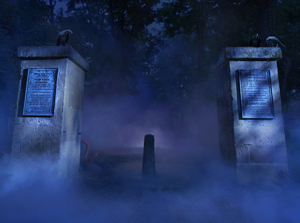The Gates of Hell

A psychic once claimed the gates of hell are located in Gambier.
Unlike other Kenyon legends, which seem to have sprouted among the corn from a stray kernel of truth, the Gates of Hell story can be traced directly to daytime TV. And its origin is based more on fact than one might imagine of a legend involving a portal to Hell.
The name is so prevalent today that many students can't recall ever hearing the stone pillars on Middle Path called anything but the Gates of Hell. Built two decades after the College was founded, they are referred to as the Gates of College Park or College Gates in archival material, names wussified by the much more strident "This Way to the Underworld" appellation.
Although some versions of the story involve a writer as the source of the tale (darn writers, always making things up), College Historian Tom Stamp '73, the College's record-setter-straighter, cites Phil Donahue and a psychic. Stamp remembers because he was there when the calls started.
So, once and for all: In the early 1980s Donahue hosted a psychic on his show who claimed to know where the entrance to Hell was located. Shortly thereafter people began calling the College, asking in earnest if the gates to, you know, Hell were in fact on campus. They expressed "how awful this was and 'couldn't we do something about it?'" Stamp said. As if the College had actually signed some sort of damnation decree allowing for the establishment of a Hell franchise. Gambier won't even allow Wendy's in.
Looking to quash the wild rumor before it could spread, Stamp got a transcript of the episode. In it he found no mention of Gambier or Kenyon.
Instead, the psychic said the Gates of Hell were located in Gahanna, most likely a reference to the suburb of around 30,000 people northeast of Columbus.
The name Gahanna comes from a Native American word meaning "meeting of the three creeks," which could not have less to do with hellfire.
But Gahanna also happens to sound a lot like "Gehenna," another name for the Valley of Hinnom from the New Testament that is described as being like Hell, where garbage was dumped and burned. (Gahanna, Ohio, has a solid waste-management reputation.)
So, apparently, Gehenna became Gahanna which, to some Phil Donahue fans' ears, became Gambier ... and a devilish campus legend was born, despite Stamp's best efforts to point out to callers that the psychic was talking about somewhere else entirely. (He didn't say "Gahanna" because he didn't want to start yet another rumor.) The College avoided publishing anything clarifying the Gambier Hell rumor, Stamp said, because they didn't want it to take on a life of its own. Bit late for that.
It wasn't the first time the Gates had earned a tough reputation.
A 1946 unattributed article in the College archives explains that the Gates were meant to ward off townsmen: "Speaking out in tones of thunder, 'Thus far shalt thou go and no farther', [they] were duly respected, and few townies ventured beyond except under the privilege of the Church."
Some superstitions linger. "I heard if you go through the Gates of Hell when the clock strikes midnight you go to Hell," said Maggie Hohlfeld '12, who added that she had never tested the theory. (Why tempt fate?)
Stamp has also heard some claim that if a car is driven down Middle Path and hits the Gates at a particular speed (66 mph?), the occupants will be transported directly to Hell, which sounds suspiciously like a major plot device from the Back to the Future movies.
Robert Alef '09 found the name cool. "It's an endearing characteristic of Kenyon," he said.
Even Stamp, who pleads with tour guides each year not to use the name, allows that it isn't used as an anti-Kenyon sentiment. Exactly.
When people say the entrance to Hell can be found on campus, they mean it in the nicest possible way.

 Delicious
Delicious Facebook
Facebook StumbleUpon
StumbleUpon Digg
Digg reddit
reddit